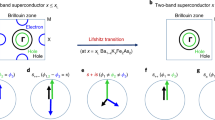Abstract
Abrikosov vortex phase in s-wave layered superconductor in a parallel magnetic field is shown to be absolutely unstable with respect to the appearance of a triplet component which breaks inversion (parity) and spin-rotational symmetries of Cooper pairs. Symmetry breaking paramagnetic effects are demonstrated to be of the order of unity if the orbital upper critical field, Hc2 (0), is of the order of Clogston paramagnetic limiting field, Hp. We suggest a generic phase diagram of such type-IV superconductor, which is singlet one at H=0 and in the Meissner phase and characterized by mixed singlet–triplet order parameter with broken symmetries of Copper pairs in vortex phase. A possibility to observe type-IV superconductivity in clean organic, high-Tc, and MgB2 superconductors is discussed.
Similar content being viewed by others
References
Abrikosov A.A. (1988). Fundamentals of Theory of Metals. Elsevier Science Publisher B.V., Amsterdam
Mineev V.P. and Samokhin K.V. (1999). Introduction to Unconventional Superconductivity. Gordon and Breach Science Publishers, Australia
We don’t use a term Type-III superconductivity to distinguish between suggested by us novel bulk phenomenon and a so-called surface superconductivity.1 Detailed theoretical studies of type-IV superconductivity phenomenon in layered s- and d-wave superconductors are performed in A. G. Lebed, Phys. Rev. Lett. 96, 037002 (2006) and , JETP Letters,82, 204 (2005) (see also preprints: condmat/0507691 and cond-mat/0507692).
Gorkov L.P. (1958). Zh. Eksp. Teor. Fiz 34:735 [ Sov. Phys. JETP 7, 505 (1958)].
Abrikosov A.A., Gorkov L.P., and Dzyaloshinskii I.E. (1963). Methods of Quantum Field Theory in Statistical Physics. Dover Publications, New York
Gorkov L.P. (1959). Zh. Eksp. Teor. Fiz 36:1918 [Sov. Phys. JETP 36, 1364 (1959)]
Abrikosov A.A. (1957). Zh. Eksp. Teor. Fiz 32:1442 [Sov. Phys. JETP 5, 1174 (1957)]
A fundamental question how to obtain vortex lattice from singlet–triplet mixed nuclei (9) will be considered in our further publications.
Salomaa M.M. and Volovik G.E. (1987). Rev. Mod. Phys 59:533
S. Matsuo, H. Shimahara, and K. Nagai, J. Phys. Soc. Jpn. 63, 2499 (1994); H. Shimahara, Phys. Rev. B 62, 3524 (2000).
Gorkov L.P. and Rashba E.I. (2001). Phys. Rev. Lett 87:037004
Author information
Authors and Affiliations
Corresponding author
Rights and permissions
About this article
Cite this article
Lebed, A.G. Type-IV Superconductivity: Can Superconductivity be more Exotic than Unconventional?. J Low Temp Phys 142, 173–178 (2006). https://doi.org/10.1007/s10909-006-9015-0
Published:
Issue Date:
DOI: https://doi.org/10.1007/s10909-006-9015-0




